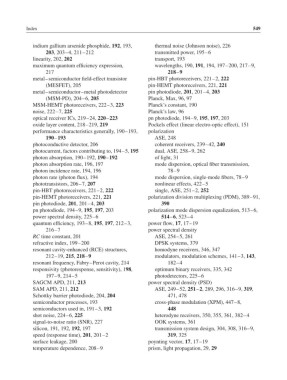Page 568 - Fiber Optic Communications Fund
P. 568
Index 549
indium gallium arsenide phosphide, 192, 193, thermal noise (Johnson noise), 226
203, 203–4, 211–212 transmitted power, 195–6
linearity, 202, 202 transport, 193
maximum quantum efficiency expression, wavelengths, 190, 191, 194, 197–200, 217–9,
217 218–9
metal–semiconductor field-effect transistor pin-HBT photoreceivers, 221–2, 222
(MESFET), 205 pin-HEMT photoreceivers, 221, 221
metal–semiconductor–metal photodetector pin photodiode, 201, 201–4, 203
(MSM-PD), 204–6, 205 Planck, Max, 96, 97
MSM-HEMT photoreceivers, 222–3, 223 Planck’s constant, 190
noise, 222–7, 225 Planck’s law, 96
optical receiver ICs, 219–24, 220–223 pn photodiode, 194–9, 195, 197, 203
oxide layer content, 218–219, 219 Pockels effect (linear electro-optic effect), 151
performance characteristics generally, 190–193, polarization
190–193 ASE, 248
photoconductive detector, 206 coherent receivers, 239–42, 240
photocurrent, factors contributing to, 194–5, 195 dual, ASE, 258–9, 262
photon absorption, 190–192, 190–192 of light, 31
photon absorption rate, 196, 197 mode dispersion, optical fiber transmission,
photon incidence rate, 194, 196 78–9
photon rate (photon flux), 194 mode dispersion, single-mode fibers, 78–9
phototransistors, 206–7, 207 nonlinear effects, 422–5
pin-HBT photoreceivers, 221–2, 222 single, ASE, 251–2, 252
pin-HEMT photoreceivers, 221, 221 polarization division multiplexing (PDM), 389–91,
pin photodiode, 201, 201–4, 203 390
pn photodiode, 194–9, 195, 197, 203 polarization mode dispersion equalization, 513–6,
power spectral density, 225–6 514–6, 523–4
quantum efficiency, 193–8, 195, 197, 212–3, power flow, 17, 17–19
216–7 power spectral density
RC time constant, 201 ASE, 254–5, 261
refractive index, 199–200 DPSK systems, 379
resonant cavity-enhanced (RCE) structures, homodyne receivers, 346, 347
212–19, 215, 218–9 modulators, modulation schemes, 141–3, 143,
resonant frequency, Fabry–Perot cavity, 214 182–4
responsivity (photoresponse, sensitivity), 198, optimum binary receivers, 335, 342
197–9, 214–5 photodetectors, 225–6
SAGCM APD, 211, 213 power spectral density (PSD)
SAM APD, 211, 212 ASE, 249–52, 251–2, 289, 296, 316–9, 319,
Schottky barrier photodiode, 204, 204 471, 478
semiconductor processes, 193 cross-phase modulation (XPM), 447–8,
semiconductors used in, 191–3, 192 448
shot noise, 224–6, 225 heterodyne receivers, 350, 355, 361, 382–4
signal-to-noise ratio (SNR), 227 OOK systems, 361
silicon, 191, 192, 192, 197 transmission system design, 304, 308, 316–9,
speed (response time), 201, 201–2 319, 325
surface leakage, 200 poynting vector, 17, 17–19
temperature dependence, 208–9 prism, light propagation, 29, 29

